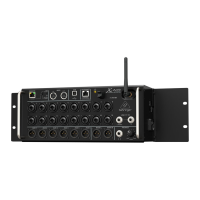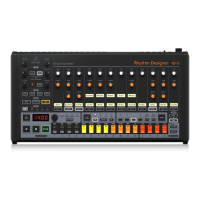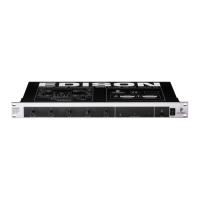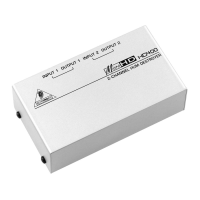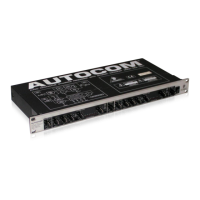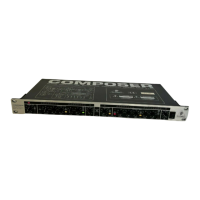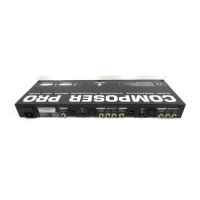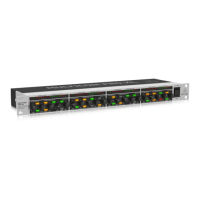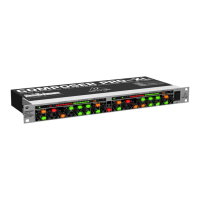Do you have a question about the Behringer ULTRADRIVE PRO DCX2496 and is the answer not in the manual?
Prepare for initial operation, including shipment inspection and warranty registration.
Guidance on how to use the manual to understand controls and functions.
Description of front panel LEDs, display, and buttons for input and output control.
Details on the rear panel fuse holder, mains connection, RS-232/RS-485 interface, and output connectors.
How to choose the output configuration for different frequency ranges.
Defining crossover frequencies and filter types for each output channel.
How to mute individual or all input/output channels for monitoring.
Instructions on how to save presets to internal memory or a PC card.
Loading previously saved presets from internal memory or memory card.
Procedure to reset the unit to its original factory default settings.
Overview of the unit's operating structure and how information is presented on the display.
Basic adjustments for operation, including input/output configuration.
Setting the general operating mode and routing of inputs to outputs.
Configuring stereo link for outputs and inputs to synchronize settings.
Adjusting delay for temperature and automatically aligning speaker phases.
Transferring settings between channels or pages for faster configuration.
Locking individual parameter pages with a password to prevent unauthorized edits.
Locking all parameter pages and store/recall functions with a password.
Adjusting display contrast, setting device ID, and configuring PC communication port.
Adjusting gain, EQ, and delay for individual input signals.
Setting the input gain level for channels A, B, and C.
Configuring delay for input signals and assigning custom names.
Applying equalization filters (LP, HP, BP) to input signals.
Adjusting frequency range gain based on signal level using dynamic EQ filters.
Configuring threshold, ratio, attack, and release for dynamic EQ.
Combining input signals to create a SUM signal for output routing.
Selecting inputs for the SUM signal and adjusting its gain.
Setting output parameters including input source, gain, name, and EQ.
Selecting input source, adjusting output gain, and assigning output names.
Defining crossover frequencies, filter types, and adjustment modes for outputs.
Activating and configuring the limiter to prevent harmful level peaks.
Correcting phase errors and adjusting phase position at upper X-OVER frequencies.
Configuring delay functions for output signals, including coupling multiple delays.
Muting individual or all input/output channels for monitoring purposes.
Recalling previously stored presets from internal memory or PCMCIA card.
Detailed steps for storing presets, naming, and overwriting existing ones.
Erasing presets from memory or formatting PCMCIA cards.
Copying presets within banks or between internal memory and PCMCIA cards.
Securing presets by locking them or unlocking them for editing.
Detailed setup for a 3-way stereo sound system using six outputs.
Configuration for a 2-way stereo system with an additional mono subwoofer.
Setting up a 3-way stereo system with left, center, and right speakers.
Using two active speakers and one mono subwoofer for stereo reproduction.
Configuring a stereo system with two subwoofers for enhanced bass response.
Setting up a stereo system with a subwoofer and an additional stage monitor.
Distributing a mono signal to six separate zones with individual EQ and delay.
Creating stereo delay lines for speaker cabinets placed at different distances.
Configuring a 3-channel surround sound system with front and rear speakers.
Building a stereo 4-way system with individually accessible on-stage monitors.
Configuring a 5-way mono system with a separate mono signal for subwoofer or monitor.
Configuration for the front left, center, and right speakers in a 5.1 system.
Configuration for rear surround speakers and subwoofer in a 5.1 system.
Details on type, connector, input level, impedance, and crosstalk for analog inputs.
Details on connector, format, input level, impedance, and sampling frequency.
Details on type, connector, input level, impedance, and phantom supply.
Details on type, connector, output level, impedance, and crosstalk for analog outputs.
Details on sampling frequency, signal delay, frequency response, dynamic range, noise, and THD+N.
Details on A/D and D/A converter resolution, oversampling, and dynamic range.
Details on RS-232 and RS-485 interface types and transmission types.
Details on mains voltage, power consumption, fuse, and physical dimensions.
Prepare for initial operation, including shipment inspection and warranty registration.
Guidance on how to use the manual to understand controls and functions.
Description of front panel LEDs, display, and buttons for input and output control.
Details on the rear panel fuse holder, mains connection, RS-232/RS-485 interface, and output connectors.
How to choose the output configuration for different frequency ranges.
Defining crossover frequencies and filter types for each output channel.
How to mute individual or all input/output channels for monitoring.
Instructions on how to save presets to internal memory or a PC card.
Loading previously saved presets from internal memory or memory card.
Procedure to reset the unit to its original factory default settings.
Overview of the unit's operating structure and how information is presented on the display.
Basic adjustments for operation, including input/output configuration.
Setting the general operating mode and routing of inputs to outputs.
Configuring stereo link for outputs and inputs to synchronize settings.
Adjusting delay for temperature and automatically aligning speaker phases.
Transferring settings between channels or pages for faster configuration.
Locking individual parameter pages with a password to prevent unauthorized edits.
Locking all parameter pages and store/recall functions with a password.
Adjusting display contrast, setting device ID, and configuring PC communication port.
Adjusting gain, EQ, and delay for individual input signals.
Setting the input gain level for channels A, B, and C.
Configuring delay for input signals and assigning custom names.
Applying equalization filters (LP, HP, BP) to input signals.
Adjusting frequency range gain based on signal level using dynamic EQ filters.
Configuring threshold, ratio, attack, and release for dynamic EQ.
Combining input signals to create a SUM signal for output routing.
Selecting inputs for the SUM signal and adjusting its gain.
Setting output parameters including input source, gain, name, and EQ.
Selecting input source, adjusting output gain, and assigning output names.
Defining crossover frequencies, filter types, and adjustment modes for outputs.
Activating and configuring the limiter to prevent harmful level peaks.
Correcting phase errors and adjusting phase position at upper X-OVER frequencies.
Configuring delay functions for output signals, including coupling multiple delays.
Muting individual or all input/output channels for monitoring purposes.
Recalling previously stored presets from internal memory or PCMCIA card.
Detailed steps for storing presets, naming, and overwriting existing ones.
Erasing presets from memory or formatting PCMCIA cards.
Copying presets within banks or between internal memory and PCMCIA cards.
Securing presets by locking them or unlocking them for editing.
Detailed setup for a 3-way stereo sound system using six outputs.
Configuration for a 2-way stereo system with an additional mono subwoofer.
Setting up a 3-way stereo system with left, center, and right speakers.
Using two active speakers and one mono subwoofer for stereo reproduction.
Configuring a stereo system with two subwoofers for enhanced bass response.
Setting up a stereo system with a subwoofer and an additional stage monitor.
Distributing a mono signal to six separate zones with individual EQ and delay.
Creating stereo delay lines for speaker cabinets placed at different distances.
Configuring a 3-channel surround sound system with front and rear speakers.
Building a stereo 4-way system with individually accessible on-stage monitors.
Configuring a 5-way mono system with a separate mono signal for subwoofer or monitor.
Configuration for the front left, center, and right speakers in a 5.1 system.
Configuration for rear surround speakers and subwoofer in a 5.1 system.
Details on type, connector, input level, impedance, and crosstalk for analog inputs.
Details on connector, format, input level, impedance, and sampling frequency.
Details on type, connector, input level, impedance, and phantom supply.
Details on type, connector, output level, impedance, and crosstalk for analog outputs.
Details on sampling frequency, signal delay, frequency response, dynamic range, noise, and THD+N.
Details on A/D and D/A converter resolution, oversampling, and dynamic range.
Details on RS-232 and RS-485 interface types and transmission types.
Details on mains voltage, power consumption, fuse, and physical dimensions.
| Type | - |
|---|---|
| Proper use | What is the intended application of the product? |
| Sample rate | 96 kHz |
| Product color | Metallic |


